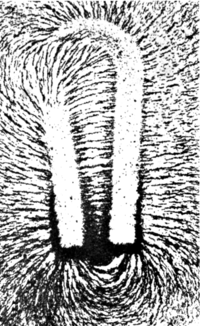
Photo from wikipedia
Abstract The geomagnetic field prevents a portion of incoming cosmic rays from reaching Earth’s atmosphere. During magnetic reversals and excursions, the field strength can decrease by up to 90% relative… Click to show full abstract
Abstract The geomagnetic field prevents a portion of incoming cosmic rays from reaching Earth’s atmosphere. During magnetic reversals and excursions, the field strength can decrease by up to 90% relative to the modern-day value. During such anomalies, cosmic ray bombardment to Earth’s atmosphere increases as evident from atmospheric 10Be anomalies recorded in sediment and ice cores. However, how the flux of cosmic rays to Earth’s surface varies during such geomagnetic anomalies is not well constrained. We measured fossil cosmogenic 3He in olivine from the tops of two pairs of 40Ar/39Ar age-dated Tahitian lava flows that erupted during the Matuyama-Brunhes reversal precursor event. We corrected these raw values for the diffusive loss of helium caused by heating from the overlying flow with a diffusion model using cooling rates and maximum temperature conditions based on field measurements of active lava flows from Kilauea, Hawaii. We assume the maximum temperature suggested by field measurements and thus present a limiting case for the highest diffusive loss corrections and thus the highest paleo-production rates. Based on paleomagnetic field strength reconstructions and scaling factor models, the upper limits of the corrected in situ 3He paleo-production rates (100 ± 23, 144 ± 35 atoms g−1 a−1) are in agreement with those expected during the period of a geomagnetic field strength low when these flow tops were exposed. However, the more plausible contact temperatures (
Journal Title: Chemical Geology
Year Published: 2020
Link to full text (if available)
Share on Social Media: Sign Up to like & get
recommendations!